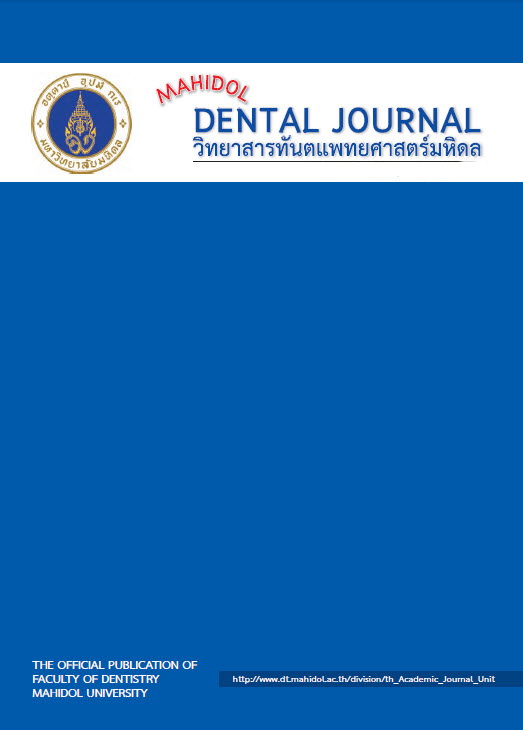Burning Mouth Syndrome in a Patient with Lymphoproliferative Disorder
Main Article Content
Abstract
Abstract
Burning mouth syndrome is characterized by the presence of burning sensation in oral cavity without sign of mucosal alteration. Because of the absence of clinical lesion, diagnosis of this abnormality is not straightforward and required combination of several information, including history, physical finding, and laboratory investigation. This article presents a case of patient with a burning sensation and numbness in the tongue. The diagnosis of secondary burning mouth syndrome was suspected. She has been suffering from lymphoproliferative disorder. Laboratory evaluation revealed abnormalities of blood cell production, as well as folate deficiency, which are the factors that cause or predispose to oral burning sensation. One month after taking vitamin supplements, improvement of symptom was achieved.
Article Details
References
2. Sun A, Wu KM, Wang YP, Lin HP, Chen HM, et al. Burning mouth syndrome: a review and update. J Oral Pathol Med. 2013;42:649-55.
3. McLean E, de Benoist B, Allen LH. Review of the magnitude of folate and vitamin B12 deficiencies worldwide. Food Nutr Bull. 2008;29:38-51.
4. Assantachai P, Lekhakula S. Epidemiological survey of vitamin deficiencies in older Thai adults: implications for national policy planning. Public Health Nutr. 2005;10:65-70.
5. Allen LH. Causes of vitamin B12 and folate dericiency. Food Nutr Bull. 2008;29:20-34.
6. Drazen JM. Drug-induced megaloblastic anemia. N Engl J Med. 2015;373:1649-58.
7. Rose DP. Folic acid deficiency in leukemia and lymphoma. J CLin Path. 1966;19:29-32.
8. Tandon S, Singh K, Ruban A, Singh B, Mahdi AA, et al. Estimate of serum folate and vitamin B12 levels in children with hematologic malignancies. Gomal J Med Sci [Internet]. 2014 [cited 2018 July 23];12. Available from:https://link.galegroup.com/apps/doc/A387773138.
9. Wongrakpanich S, George G, Chaiwatcharayut W, Candelario N, Mittal V, et al. The frequency of folate deficiency in multiple myeloma patients. Blood. 2015;126:5302.
10. Degar BA, Berliner N. Introduction to the lymphoproliferative disorders. In: Warrell DA, Cox TM, Firth JD, editors. Oxford Textbook of Medeicine: Oxford University Press [Internet];2013 [cited 2018 July 24]. Available from: https://www.oxfordmedicine.com.
11. Moticka EJ. Lymphoproliferative diseases. In: Moticka EJ, editor. A Historical Perspective on Evidence-Based Immunology: Elsevier Inc; 2015. P.309-16.
12. Ghosh J, Singh RK, Saxena R, Gupta R, Vivekanandan S, et al. Prevalence and aetiology of anaemia in lymphoid malignancy. Natl Med J India. 2013;16:79-81.
13. Feller L, Fourie J, Bouckaert M, Khammissa RAG, Ballyram R, et al. Burning mouth syndrome: aetiopathogenesis and principles of management. Pain Res Manag [Internet]. 2017 [cited 2018 July 24]. Available from: https://doi.org/10.1155/2017/1926269.
14. Regina D, Raj S, Rao R. Correlation of pallor with hemoglobin levels and clinical profile of anemia in primary and middle school children of rural Telangana. Int J Contemp Pediatr. 2016;3:872-7.
15. Lewis MAO, Williams DW. Diagnosis and management of oral candidosis. BDJ. 2017;223:675-81.
16. Županić-Krmek D, Lang N, Jurčić D, Ljubić N, Bilić A. Analysis of the influence of various factors on anemia in patients with lymphoid malignancies. Acta Clin Croat. 2011;50:495-500.
17. Naoum FA. Iron deficiency in cancer patients. Rev Bras Hematol Hemater. 2016;38:325-30.
18. Raju SB, Rajappa S. Isolation and identification of Candida from the oral cavity. ISRN Dent [Internet]. 2011 [cited 2018 July 24]. Available from: https://doi/10.5402/2011/487921.
19. Tooyama H, Matsumoto T, Hauashi K, Kurashina K, Kurita H, et al. Candida concentrations determined following concentrated oral rinse culture reflect clinical oral signs. BMC Oral Health [Internet]. 2015 [cited 2018 July 24];15. Available from: https://doi/10.1186/s12903-015-0138-z.
20. Davis AS, Viera AJ, Mead MD. Leukemia: an overview for primary care. Am Fam Physician. 2014;89:731-8.
21. Singh A, Hungund B, Kumar L, Pattanshetti M. Clinico-haematological profile of patients with bicytopenia. Haematology. 2018;50:540-8.
22. Killip S, Bennett JM, Chambers MD. Iron deficiency anemia. Am Fam Physician. 2007;75:671-8.
23. Wians FH, Urban JE, Keffer JH, Kroft SH. Discrimination between iron deficiency anemia and anemia of chronic disease using traditional indices of iron status vs transferrin receptor concentration. Am J Clin Pathol. 2001;115:112-8.
24. Spivak JL. Iron and the anemia of chronic disease. 2002; Oncology;16:25-33.
25. Adamson JW. The anemia of inflammation/malignancy: mechanisms and management. Hematology. 2008:159-65.
26. Harrington DJ. Laboratory assessment of vitamin B12 status. J Clin Pathol. 2017;70:168-73.
27. Klee GG. Cobalamin and folate evaluation: measurement of methylmalonic acid and homocysteine vs vitamin B12 and folate. Clin Chem. 2000;46:1277-83.
28. WHO. Serum and red blood cell folate concentrations for assessing folate status in populations. Vitamin and Mineral Nutrition Information System [Internet]. Geneva, World Health Organization. 2012 [cited 2018 July 29]. Available from: https://apps.who.int/iris/bitstream/10665/75584/1/WHO_NMH_NHD_EPG_12.1_eng/pdf
29. Lin HP, Wang YP, Chen HM, Kuo YS, Lang MJ. et al. Significant association of hematinic deficiencies and high blood homocysteine levels with burning mouth syndrome. J Formos Med Assoc. 2013;112:319-25.
30. Vucicevic-Boras V, Topic B, Cekic-Arambasin A, Zadro R, Stavljenic-Rukavina A. Lack of association between burning mouth syndrome and hematinic deficiencies. Eur J Med Res. 2001;6:409-12.
31. Verenzuela CSM, Davis MDP, Bruce AJ, Torgerson RR. Burning mouth syndrome: results of screening tests for vitamin and mineral deficiencies, thyroid hormone, and glucose levels-experience at Mayo Clinic over a decade. Int J Dermatol. 2017;56:952-6.
32. Krasteva A, Kisselova A, Dineva V, Ivanova A, Krastev Z. Folic acid and vitamin B12 levels in Bulgarian patients with burning mouth syndrome. J of IMAB. 2013;19:422-5.
33. Terai H, Shimahara M. Glossodynia from Candida-associated lesions, burning mouth syndrome, or mixed causes. Pain Med. 2010;11:856-60.
34. Maurer DM. Screening for depression. Am Fam Physician. 2012;85:139-44.
35. Sun A, Lin HP, Wang YP, Chen HM, Cheng SJ, et al. Significant reduction of serum homocysteine level and oral symptoms after different vitamin-supplement treatments in patients with burning mouth syndrome. J Oral Pathol Med. 2013;42:474-9.
36. Devalia V, Hamilton MS, Molloy AM. Guidelines for the diagnosis and treatment of cobalamin and folate disorders. Br J Haematol. 2014;166:496-513.
37. Turner MD. Hyposalivation and xerostomia; etiology, complications, and medical management. Dent Clin N Am. 2016;60:435-43.

